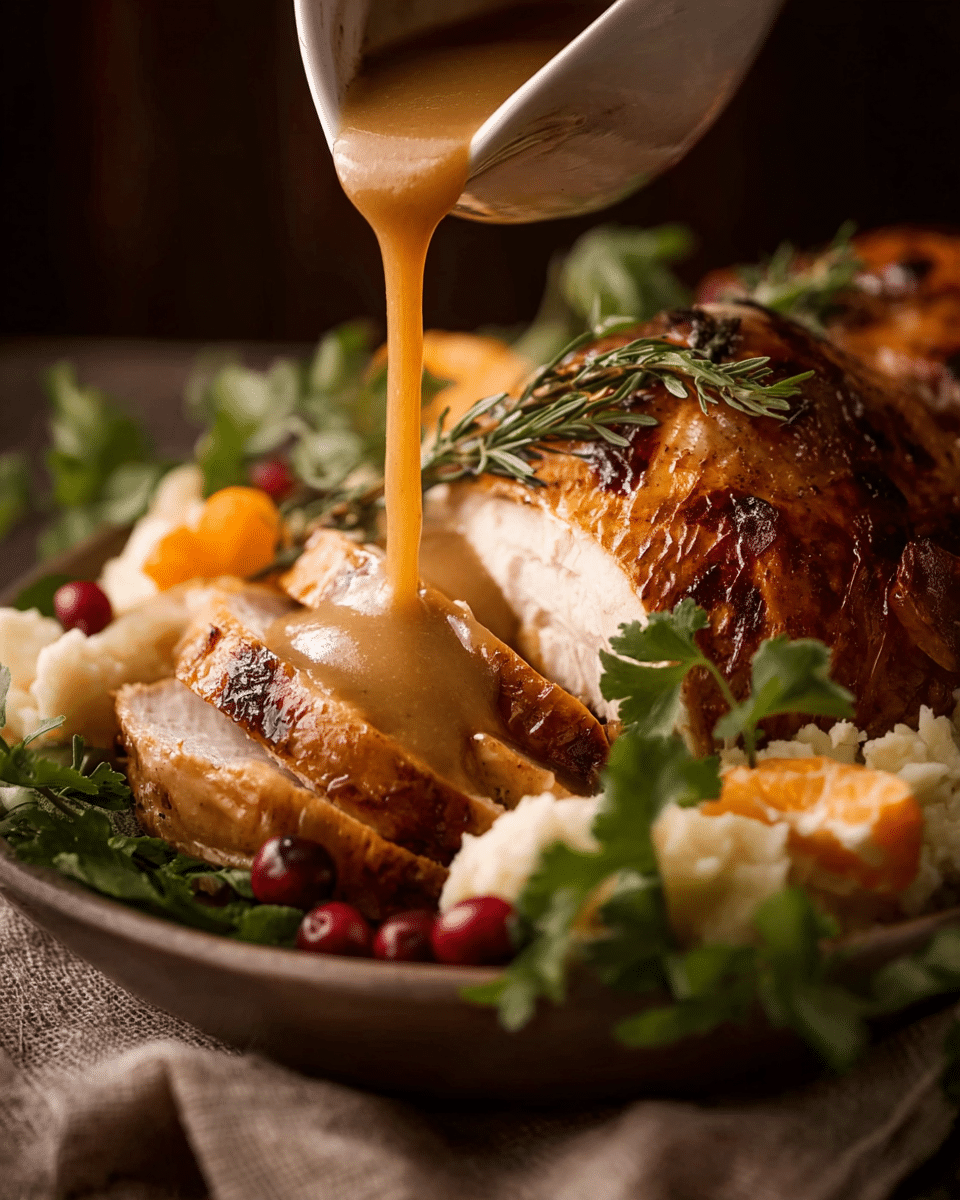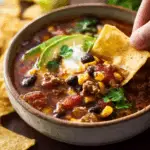The rich and luscious turkey gravy made from pan drippings is the crowning glory of any holiday feast. Made right in the roasting pan, this gravy captures every last drop of flavor from the roasted turkey, herbs, and aromatics.
Its velvety texture and deep, savory notes bring a comforting and indulgent element to your Thanksgiving spread. Whether ladled generously over slices of tender turkey, creamy mashed potatoes, or stuffing, this gravy ties the whole meal together in the most delicious way.
Full Recipe:
-
6 tbsp turkey pan drippings (or a combination of drippings and unsalted butter)
-
6 tbsp all-purpose flour
-
4 cups low-sodium chicken or turkey broth
-
Salt and pepper, to taste
Directions:
-
Place your turkey roasting pan directly over medium heat on the stovetop. If the pan spans two burners, even better.
-
Leave in all the roasted aromatics (onion, garlic, herbs) from the turkey pan.
-
Once the drippings begin to bubble, sprinkle in the flour and stir constantly for 1 minute to cook off the raw flour taste.
-
Slowly pour in the broth, whisking constantly to prevent lumps.
-
Let the gravy simmer, stirring occasionally, until thickened to your desired consistency.
-
Season with salt and pepper.
-
Strain the gravy into a bowl, pressing all juices from solids.
-
Pour into a gravy boat and serve warm. Tip: Use a thermos to keep it hot until ready to serve.
Prep Time: 5 minutes | Cooking Time: 15 minutes | Total Time: 20 minutes
Kcal: 60 kcal per 1/4 cup | Servings: 12 servings (4 cups)
The Soul of the Holiday Table: Why Turkey Gravy Matters
In the grand feast that is Thanksgiving or any holiday roast dinner, turkey gravy often plays the role of the unsung hero. While the turkey garners much of the glory, and the mashed potatoes take up valuable plate space, it is the gravy that ties every dish together. Its warm, velvety pour infuses the meal with flavor, moisture, and depth, transforming simple ingredients into a cohesive culinary experience.
Turkey gravy is more than just a sauce—it’s the rich, comforting link between turkey, sides, and stuffing. It serves not only as a flavor booster but also as a nostalgic nod to holiday meals of the past. For many home cooks, the act of making gravy is steeped in tradition and, at times, anxiety. But with the right base and method, anyone can create gravy that’s both flavorful and foolproof.
What Makes Turkey Gravy So Special?
What sets turkey gravy apart from other gravies is its reliance on pan drippings. These are the flavorful juices and browned bits left in the roasting pan after cooking the turkey. Combined with a thickener (like flour) and a liquid (usually broth), pan drippings create a sauce that embodies the very essence of the roasted bird.
This gravy is not just an afterthought. It’s layered with savory, umami-rich depth that comes from the caramelization of onions, garlic, and herbs cooked beneath the turkey. As the bird roasts, these aromatics absorb the meat’s fat and juices, intensifying their flavor. When whisked into the gravy, they become its flavorful backbone.
Even visually, a beautifully made turkey gravy is a feast for the eyes—glossy, rich, and golden brown. It’s the perfect contrast to pale turkey breast and fluffy mashed potatoes, and it adds a luscious sheen to your plate that signals indulgence and home-cooked goodness.
The Science Behind Perfect Turkey Gravy
Creating a good gravy is both art and science. One of the core elements is the roux, a mixture of fat (from pan drippings or butter) and flour. This is cooked briefly to eliminate the raw flour taste and to thicken the gravy without lumps. The magic happens as the broth is added slowly, with constant stirring or whisking, allowing the mixture to become silky and smooth.
Temperature and timing also matter. Adding liquid too quickly or at the wrong temperature can result in a lumpy or thin gravy. Too little cooking, and it tastes floury. Too much, and it might become overly thick. But when done right, the consistency becomes pourable, luxurious, and clingy enough to coat everything on the plate.
Some chefs enhance their gravy with wine or add umami elements like soy sauce or Worcestershire sauce to deepen its color and flavor. These additions don’t make the gravy taste foreign or overly seasoned; instead, they bring a subtle complexity that elevates the dish.
Two Paths to Great Gravy: Roasted vs. Slow Cooker
Depending on how you cook your turkey, there are two main ways to approach the gravy.
If your turkey is oven-roasted, the drippings from the pan are used directly. This includes the fat, juices, and the browned bits stuck to the pan’s surface. These are gold when it comes to flavor. Many cooks choose to leave the roasted garlic and onions in the pan while making the gravy to extract every ounce of flavor.
For slow cooker turkeys, the method is slightly different. Because there’s no roasting pan involved and fewer drippings, the juices that collect in the slow cooker are strained and used as the base. If there’s not enough fat, butter is added. While the flavor can be just as good, slow cooker gravy is often lighter in color unless a darkener is added.
A simple trick to deepen the color of pale gravy is to use dark soy sauce. While this may seem unconventional, it does wonders without adding an overtly Asian flavor. It enhances both appearance and seasoning in one step, offering a practical and clever solution for a more appetizing presentation.
Common Mistakes to Avoid
Gravy is simple, but it’s not always easy. Here are some pitfalls to steer clear of:
-
Not using enough drippings: Skimping on the flavorful fat from the pan results in bland gravy. If you’re short, supplement with butter.
-
Adding all the broth at once: This can cause lumps and uneven thickening. Slowly whisking in the liquid is crucial.
-
Under-seasoning: Remember, gravy is meant to enhance everything it touches. Taste at the end and adjust salt and pepper accordingly.
-
Ignoring texture: Too thin? Simmer to reduce. Too thick? Whisk in a splash of broth or water until it loosens to the right consistency.
-
Skipping the straining: Even if you love rustic gravies, straining ensures a smoother finish and removes fibrous bits from herbs or aromatics.
How to Make It Ahead of Time
Gravy is a perfect candidate for preparing in advance. It can be stored in the refrigerator for up to five days and freezes beautifully for up to three months. When reheated, it returns to its original texture—especially if you thin it slightly with stock or water while warming it on the stove.
To keep it warm for serving, consider storing it in a thermos. This helps avoid reheating on the fly, prevents a skin from forming, and ensures it stays at the perfect serving temperature without added stress.
Variations for Dietary Needs
While traditional gravy uses flour, it’s easy to make it gluten-free. Simply replace the flour with a cornstarch slurry (cornstarch mixed with a bit of cold water). This swap produces a glossy, slightly lighter texture but maintains that rich flavor.
Vegans can also enjoy a variation by using plant-based butter or oil, and substituting the pan drippings with mushroom broth or roasted vegetable stock. A splash of tamari or soy sauce adds depth without the meat.
Pairing Suggestions and Leftover Ideas
Turkey gravy is naturally served with turkey, but it shines just as brightly on other components of the holiday meal:
-
Drizzle it over mashed potatoes for a creamy, savory boost.
-
Pour it onto stuffing to bring it back to life.
-
Use it as a sandwich spread the next day—think open-faced turkey sandwiches or stuffing paninis.
Leftover gravy can also be used to make soups, pot pies, or reheated to pour over roasted vegetables. It adds moisture and flavor wherever it goes, making it one of the most versatile condiments in your holiday kitchen.
The Cultural and Emotional Role of Gravy
Beyond its culinary value, gravy has emotional resonance. For many families, the responsibility of making the gravy falls to a trusted cook—often a parent or grandparent—who’s perfected the technique over decades. It’s one of those recipes that isn’t just taught but passed down, tweaked with whispers of secret ingredients and inherited wisdom.
Gravy is also one of the most talked-about parts of the meal. Whether it’s delight over how well it turned out or friendly debate about how it should taste, it’s always a conversation piece. A successful gravy is often seen as the mark of a well-executed meal.
Conclusion: More Than Just Sauce—It’s Tradition in Liquid Form
Turkey gravy may seem like a humble sauce, but it carries the weight of tradition, flavor, and family heritage. It’s what transforms turkey from good to great and elevates even the simplest sides to something worth savoring. It’s the element that ties the meal together—literally and metaphorically—reminding us that the best dishes are often the ones that take what we already have and turn it into something extraordinary.
Whether you’re a first-time host or a seasoned home chef, mastering turkey gravy is a skill that will serve you well every holiday season. With a little patience, some thoughtful seasoning, and those golden pan drippings, you’ll be on your way to creating a sauce so good it will have everyone asking for seconds—and maybe even the recipe.






